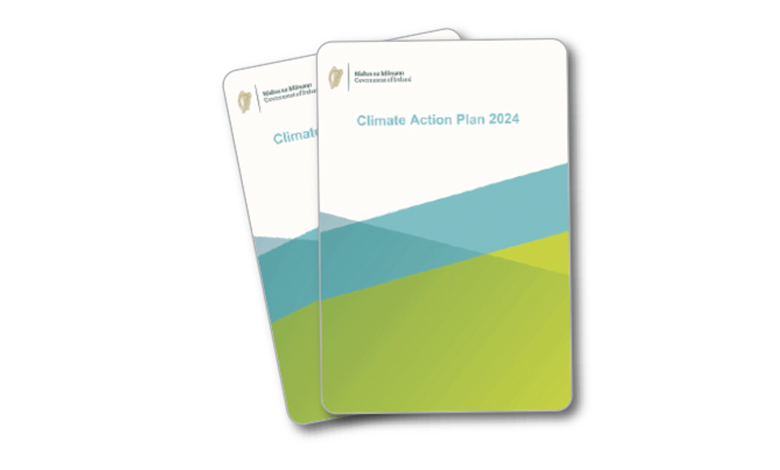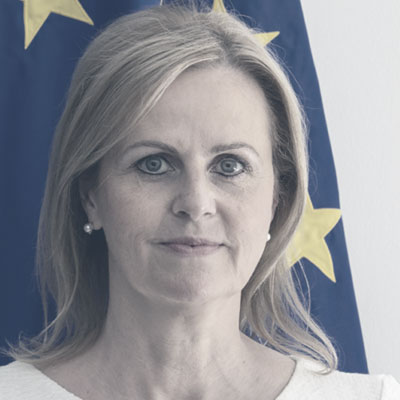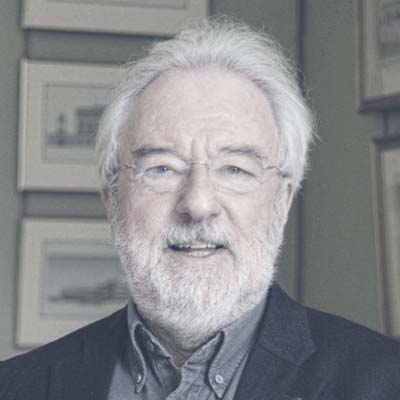
European priorities for the environment
15th December 2023
Building a more secure future in the face of climate change
19th February 2024 Although the Government says that Climate Action Plan 2024 (CAP24) “sets out the roadmap to deliver on Ireland’s climate ambition”, the report notes that, even if targeted measures outlined in previous CAPs are fully implemented, the State will still fall “significantly short” of meeting its environmental targets.
Although the Government says that Climate Action Plan 2024 (CAP24) “sets out the roadmap to deliver on Ireland’s climate ambition”, the report notes that, even if targeted measures outlined in previous CAPs are fully implemented, the State will still fall “significantly short” of meeting its environmental targets.
The State is legally obliged to halve its emissions by 2030 and achieve net zero greenhouse gas emissions by 2050.
Climate Action Plan 2024 (CAP24) outlines that estimates from the Environmental Protection Agency (EPA) indicate that Ireland’s greenhouse gas (GHG) emissions fell by 1.9 per cent in 2022 compared to 2021, driven by higher fuel prices, reduced use of nitrogen fertiliser, increased renewable energy, behavioural change, and regulation.
In terms of progress under the Climate Action Plan framework so far, CAP24 states that:
• initial indications for 2023 show a stronger fall in emissions from electricity, agriculture, and heating;
• this reduction falls short of the level of abatement required to meet national and international targets. Further, corrective actions are included in Climate Action Plan 2024 in response to this;
• the key sources of Ireland’s overall GHG emissions in 2022 are agriculture (34.3 per cent), transport (17.1 per cent), and energy industries (14.8 per cent); and
• Ireland has expended 47 per cent of its emissions for the first carbon budget period (2021-2025) in the budget’s first two years.
Although CAP24 is the third annual update to the Climate Action Plan, and the second in the aftermath of the Climate Action and Low Carbon Development (amendment) Act 2021, it has received minimal coverage compared to its preceding updates, apparently due to the lack of policy updates and the pessimistic vision it paints for the State achieving its emissions reductions targets.
The main update to the Climate Action Plan in this update is in the sector of land use, land use change, and forestry (LULUCF), owing to updated EU legislation which sets new requirements for the sector. However, even if all measures outlined in the LULUCF sector are met, this will not come close to meeting the State’s wider emissions reduction challenges.
Although there is pessimistic reading for whether the State will meet its emissions reductions targets, there is little overall by the way of updates to the core policies that the Government is pursuing.
Land use, land use change, and forestry (LULUCF)
In 2023, there was a revision to the EU legislation for LULUCF as part of the EU’s Fit for 55 package. This revision set binding LULUCF targets for Ireland. The EU legislation requires Ireland to meet a 2030 emissions reduction target and comply with a 2026-2029 carbon budget.
LULUCF was not included as a sector within the State’s initial carbon budgets due to plans which were in place for the publication of a land-use strategy. Although the Government was due to publish a land-use strategy by Q4 2023, at the time of print this has not yet taken place.
The 2030 distance to target for the State in the LULUCF sector is fixed at 0.626 MtCO2eq below a baseline set at the average of the 2016-2018 emissions.
The reported emissions in the LULUCF sector remain in flux as the Department of the Environment, Climate and Communications indicates that its understanding of emissions and activity for this sector is still advancing. The 2018 baseline, as reported in the 2021 National Inventory Report (NIR) has in the latest 2023 report increased by 31 per cent. The most recent refinements were driven by changes in the emissions factor for forestry on peat soils.
Multiple inventory refinements are scheduled for the coming decade, resulting in further fluctuations to the baseline, in parallel with current and projected emissions trends for the sector out to 2030 and beyond.
The revised EU LULUCF Regulation has a two phased approach. Until 2025, old EU regulations based on the “no debit” rule (where accounted LULUCF emissions are to be compensated by an equivalent emissions removal within the sector) are largely in place. For 2026-2029, a carbon budget is set. The budget is determined by an assumed linear reduction in emissions starting from 2022. The starting point is based on average emissions from 2021, 2022, and 2023 and the end point based on the 2030 target.
Electricity
CAP24 states that it will be “extremely difficult” for the electricity sector to remain within the carbon budgets outlined in previous updates to the Climate Action Plan.
In spite of the limitations to the electricity sector, and the fact that Ireland’s proportion of emissions from the electricity sector is now in line with the EU average, there is little by the way of substantive changes to policies. Rather, CAP24 reiterates the importance of ensuring that previously outlined policies are implemented.
Given that the programme of large-scale offshore wind deployment is expected to be realised towards the end of the decade, CAP24 outlines that deployment rates for onshore renewables will need to increase to match demand growth to ensure we keep electricity emissions within range of the carbon budgets. Achieving this will require significant upscaling and accelerating in current deployment of renewables, particularly onshore wind.
As an example, the historical average deployment of onshore wind installed capacity connected between 2008 and 2020 inclusive was 280MW per annum from 19 projects (with an annual maximum of 612MW). To achieve the necessary emissions abatement, an approximately eight-times increase of renewable energy deployment to 2.3GW annually would be needed between 2024 and 2030.
The ongoing revision of the National Planning Framework, the Renewable Electricity Spatial Planning Framework, and the implementation of the recast Renewable Energy Directive, including the mapping of Renewable Acceleration Areas, are aimed at supporting this.
Built environment
In spite of the Government’s much-touted National Retrofit Plan and ambitions to introduce district heating in urban areas, fossil fuels continue to account for more than 72 per cent of energy used in the residential sector in the State.
In its 2023 annual review, the Climate Change Advisory Council (CCAC) indicated that 45 per cent and 41 per cent of the budgets for the residential and commercial/public sectors respectively were expended in the first two years of the first carbon budgetary period, and while these sectors are aligning with their target there is still potential for further emissions reduction measures to be taken.
Given that the decrease in emissions in the built environment between 2021 and 2022 was partly due to increased fossil fuel prices and a mild winter, there is a risk that the abatement associated with fossil fuel price and supply effects may not be embedded in household heat demand over the longer term, and continued emphasis on long-term energy efficient behaviours and decarbonised technologies are key.
Agriculture
Although the original Climate Action Plan was targeting a reduction in emissions of 10 per cent by 2025 in the agriculture sector, CAP24 shows that, since the original plan was published in 2021, that there has been no progress and that agricultural emissions remain the same as they were in 2019.
Although no progress has been made, CAP24 outlines the Government’s confidence that existing policies are the answer, with the Food Vision 2030 strategy and the Teagasc Marginal Abatement Cost Curve both highly touted by government.
Food Vision 2030 has the objective of achieving a climate-neutral food system by 2050, with verifiable progress achieved by 2030, encompassing emissions, biodiversity, and water quality, as well as a range of other targets for forestry, fisheries, organic farming, and food waste.
However, under Food Vision 2030, the only meaningful steps that have been taken so far are that a number of working groups have been established whose remit includes work to further develop options for emissions reduction in the sector.
In addition, through stakeholder engagement, the Department of the Environment, Climate and Communications states that a major stumbling block to reduction of agriculture emissions is that a significant number of farmers believe that initiatives being pursued by government are “unfair”.
CAP24 proposes “incentivising”, in an unclear manner, use of low emission feed and fertiliser. It further proposes “increasing focus on low methane traits within animal breeding programmes”, with expansion of data retention promoted as “key” to enabling methane reductions.
Speaking on RTÉ’s Morning Ireland the day after the publication of Climate Action Plan 2024, Minister for the Environment, Climate and Communications Eamon Ryan TD admitted that the Government is “not on track” to meet its emissions reductions targets.
Minister Ryan further mooted the prospect of changing the way climate policy is updated on an annual basis, explaining: “The science of climate emissions and land use is really complicated and that baseline of what the actual emissions are keeps changing.
“One of the main items in the plan… is recognising a lot of the forestry we planted back 30 and 40 years ago actually was not in the right location.
“It was in very peaty soils. So, we are going to have to change and adapt our whole forestry industry towards a better system.”





 Ossian Smyth TD
Ossian Smyth TD Florika Fink-Hooijer
Florika Fink-Hooijer Antoine Oger
Antoine Oger Laura Curtis-Moss
Laura Curtis-Moss Anthony Costello
Anthony Costello Anja Murray
Anja Murray Niall Ó Donnchú
Niall Ó Donnchú Mike Savage
Mike Savage Brian Carroll
Brian Carroll Claire Downey
Claire Downey Oisín Coghlan
Oisín Coghlan Stephen Onakuse
Stephen Onakuse Kevin O’Sullivan
Kevin O’Sullivan Susan Hegarty
Susan Hegarty Hendrik W van der Kamp
Hendrik W van der Kamp Philip Nugent
Philip Nugent Adrian Smyth
Adrian Smyth  Ainhoa Gonzalez Del Campo
Ainhoa Gonzalez Del Campo  Geoff Dooley
Geoff Dooley  Clare Pillman
Clare Pillman  David Greenfield
David Greenfield Danielle Conaghan
Danielle Conaghan Peter McEvoy
Peter McEvoy Triona McGrath
Triona McGrath J Owen Lewis
J Owen Lewis Gavin Smith
Gavin Smith Imelda Hurley
Imelda Hurley Lucy Gaffney
Lucy Gaffney Dr Venkatesh Kannan
Dr Venkatesh Kannan Kevin Hegarty
Kevin Hegarty Eimear Cotter
Eimear Cotter Aditya Arora
Aditya Arora Patric Child
Patric Child Eleanor Roche
Eleanor Roche Andy Bleasdale
Andy Bleasdale Andrew Muir MLA
Andrew Muir MLA Chris Hewitt
Chris Hewitt Francesca Racioppi
Francesca Racioppi Christopher Hammond
Christopher Hammond Laura Díaz Anadón
Laura Díaz Anadón Lorna McAdoo
Lorna McAdoo Conor Murphy
Conor Murphy  Mark Horton
Mark Horton  Niall McLoughlin
Niall McLoughlin  Zoe Kavanagh
Zoe Kavanagh Niall Ó Donnchú
Niall Ó Donnchú Venkatesh Kannan
Venkatesh Kannan David McGee
David McGee Anna Rose
Anna Rose Paul Hogan
Paul Hogan








